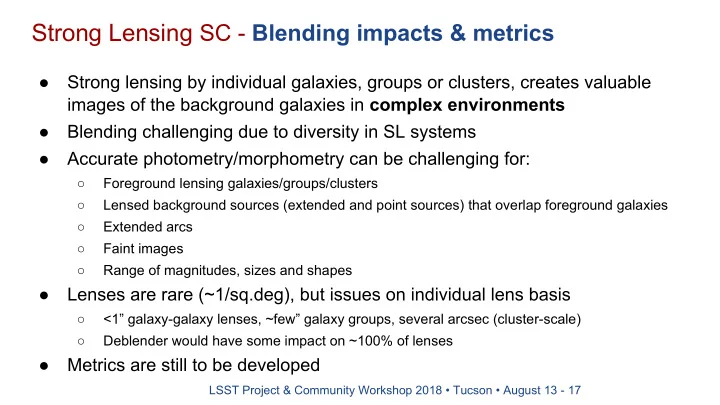

Strong Lensing SC - Blending impacts & metrics ● Strong lensing by individual galaxies, groups or clusters, creates valuable images of the background galaxies in complex environments ● Blending challenging due to diversity in SL systems ● Accurate photometry/morphometry can be challenging for: ○ Foreground lensing galaxies/groups/clusters ○ Lensed background sources (extended and point sources) that overlap foreground galaxies ○ Extended arcs ○ Faint images ○ Range of magnitudes, sizes and shapes ● Lenses are rare (~1/sq.deg), but issues on individual lens basis ○ <1” galaxy-galaxy lenses, ~few” galaxy groups, several arcsec (cluster-scale) ○ Deblender would have some impact on ~100% of lenses ● Metrics are still to be developed LSST Project & Community Workshop 2018 • Tucson • August 13 - 17
Strong Lensing Science Collaboration - Simulations & tools ● DESC / SLSC Simulations & data sets: ○ DESC DC1 and DC2 contain SL quasars and SL SN host galaxies (focussed on DE applications) ○ DESC/SLSC discussion on a wider set of SL sims (e.g. T. Collett LensPop, A. More SimCT) to be ingested into DC2/3 ○ Includes realistic blending by definition ○ Large samples of lenses and “imposters” (incl HSC) ○ Catalogue level searches (SLRealizer, J. Park, P. Marshall et al.) Tools & Metrics (to be developed): ● ○ Determine photometric accuracy & impact on derived parameters ■ Time-variable cases - lensed QSO time delays, lensed SNe on host galaxy backgrounds (DESC DC2) ■ Explore range of properties with R Ein , lens+source brightness, lens+source morphologies, diversity of image Lensed QSO in DESC DC1/Twinkles Bryce Kalmbach & Simon Krughoff configurations etc. LSST Project & Community Workshop 2018 • Tucson • August 13 - 17
Strong Lensing S cience Collaboration - Existing algorithms ● Lens subtraction & photometry codes exist ● Explore SCARLET with range of SL cases ○ Galaxy-scale, group-scale, cluster scale... ■ Catalogue vs. image based searches ■ Optimise parameters prompt & release products ○ Hidden lenses (low R Ein ) ■ “Survey” mode - some SLs SCARLET undetected sources (post-deblend extraction) ■ “Targeted” mode - e.g. Blue Rings (T. Collett et al.) ● Evaluate & compare performance ○ Finding lenses (e.g. presence in deblended catalogues) ○ Measuring lenses (e.g. accuracy of resultant deblended photometry & derived properties) LSST Project & Community Workshop 2018 • Tucson • August 13 - 17
Strong Lensing SC - Blending impacts & metrics ● Describe types of impact(s) of blending on your science. ● Types of objects that are most relevant: ○ galaxies/stars/other? ~magnitude, size, shape… ● Density of these objects (#/sq arcmin) and/or fraction of objects impacted by blending: ○ What fraction or number are “blended” or could be impacted by a “deblender”? ● Have any metrics for evaluating the impact of blending on your science already been identified and/or tested? If so, what are they? ○ xxxx LSST Project & Community Workshop 2018 • Tucson • August 13 - 17
Strong Lensing Science Collaboration - Simulations & tools ● Simulations & data sets: ○ Do simulations exist for studying the impact of blending on your science, or would your SC benefit from further development of sims? If so, at the catalog level? Pixel level? Simulated objects embedded in real data? Parameterized or realistic shapes? ○ Do existing relevant simulations include LSST filters? Do they simulate to LSST full depth? Do they include “realistic” blending? ○ Is your SC using any data sets that combine space (“truth”) and ground? ● Tools: ○ Have any tools already been developed to test algorithms that address detection/deblending and to evaluate blending-related metrics for your SC? LSST Project & Community Workshop 2018 • Tucson • August 13 - 17
Strong Lensing S cience Collaboration - Existing algorithms ● Are existing or planned (e.g., LSST DM/Scarlet) algorithms and pipelines expected to meet your science requirements for handling blending objects? ○ If so, which ones? ○ If not, what are the issues? ● Anything else we should all know about blending challenges for your science collaboration, relevant resources, etc.? ○ xxxx LSST Project & Community Workshop 2018 • Tucson • August 13 - 17
Recommend
More recommend